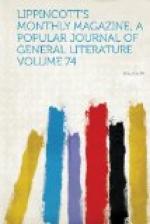Notwithstanding the magnificence of the present quarters of the club to which I have referred, one cannot help regretting that, unlike the Agricultural Society and the Club of the Champs Elyses, it is obliged to confine itself to one story of the building—the first floor, according to continental enumeration—though the rental of this floor alone amounts to some three hundred thousand francs a year.
The committee on races, composed of fifteen members (founders) and fifteen associate members—the latter elected every year by the founders—represents the club in all that concerns its finances and property, votes the budget, the programme of all races and the conditions of the prizes, and not only legislates in making the laws that govern the course, but acts also as judge in deciding questions that may arise under the code that it has established. And as a legislative body it has its hands almost as full as that of the state, for the budget of the society grows from year to year as rapidly as the nation’s, and there are now forty-nine turfs for which it is responsible or to which it has extended its protection. The presidency of the committee, after having been held for many years by the lamented Vicomte Daru, passed on his death last year to M. Auguste Lupin, the oldest proprietor of race-horses in France. To M. Lupin, moreover, belongs the honor of being the first breeder in France who has beaten the English in their own country by gaining the Goodwood Cup in 1855 with Jouvence—success that was renewed by his horse Dollar in 1864. M. Lupin, who had six times won the Jockey Club Purse (the French Derby) and twice the Grand Prix de Paris, occupies very much the same position in France that Lord Falmouth holds in England, and, like him, he never bets. His colors, black jacket and red cap, are exceedingly popular, and received even more than their wonted share of applause in the year 1875, the most brilliant season in the history of his stables, when he carried off all the best prizes with St. Cyr, Salvator and Almanza. His stud, which has numbered amongst its stallions the Baron, Dollar and the Flying Dutchman, is at Vaucresson, near Versailles. His training-stables are at La Croix, St. Ouen.
Of the remaining members of the committee on races, the best known are the prince de la Moskowa, the comte A. de Noailles, Henry Delamarre, Comte Frederic de Lagrange, Comte A. des Cars, J. Mackenzie-Grieves, Comte H. de Turtot, the duc de Fitz-James, Baron Shickler, the prince A. d’Aremberg, Prince Joachim Murat, Comte Roederer, the marquis de Lauriston, Baron Gustave de Rothschild, E. Fould and the comtes de St. Sauveur, de Kergorlay and de Juigne. Most of these gentlemen run their horses, or have done so, and the list will be found to comprise, with two or three exceptions, the principal turfmen of France. The comte de Juigne and the prince d’Aremberg, both very rich, and much liked in Paris, have formed a partnership in turf matters, and the colors they have adopted,




